Ginger: Diseases and Symptoms
Ginger: Diseases and Symptoms
Soft rot
Disease symptoms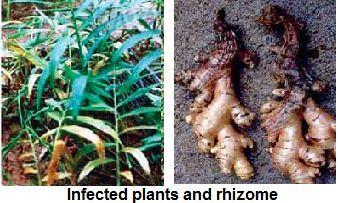 The infection starts at the collar region of the pseudo stem and progresses upwards as well as downwards.
The infection starts at the collar region of the pseudo stem and progresses upwards as well as downwards.- Affected pseudo stem becomes water soaked and the rotting spreads to the rhizome resulting in soft rot. At a later stage root infection is also noticed.
- Foliar symptoms appear as light yellowing of the tips of lower leaves which gradually spreads to the leaf blades.
- In early stages, the middle portion of the leaves remain green while the margins become yellow.
- The yellowing spreads to all leaves of the plant from the lower region upwards and is followed by drooping, withering and drying of pseudo Stems.
- The disease is soil-borne.
- The fungus can survive in two ways: (a) in diseased rhizomes kept for seed, and (b) through resting structures like chlamydo spores and oospores that reach the soil from infected rhizomes.
- The fungus multiplies with buildup of soil moisture with the onset of south west monsoon.
- Younger sprouts are the most susceptible to the pathogen. Nematode infestation aggravates rhizome rot disease.
- A high temperature above 30° C and high soil moisture are the important predisposing factors favouring the disease.
- Waterlogging in the field due to poor drainage increases the intensity of the disease.
Bacterial wilt
Disease symptoms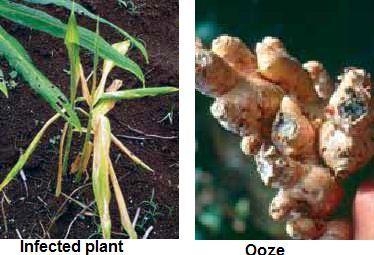 Water soaked spots appear at the collar region of the pseudo stem and progresses both side upwards and downwards.
Water soaked spots appear at the collar region of the pseudo stem and progresses both side upwards and downwards.- The first conspicuous symptom is mild drooping and curling of leaf margins of the lower leaves which spread upwards.
- Yellowing starts from the lowermost leaves and gradually progresses to the upper leaves.
- In the advanced stage, severe yellowing and wilting symptoms occurs.
- The vascular tissues of the affected pseudo stems show dark streaks.
- The affected pseudo stem and rhizome when pressed gently extrudes milky ooze from the vascular strands. Ultimately rhizomes get rotted.
- Bacterial wilt is a soil and seed borne disease that occurs during south west monsoon.
- The bacteria are spread through soil, water, infected or contaminated rhizomes.
- The bacteria enter the plant through wounds made in the roots during transplanting, through agricultural equipment’s, nematodes and insects.
- Relatively high soil moisture and soil temperature
- Disease, occurs during south west monsoon.
Leaf spot
Disease symptoms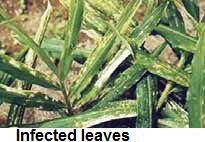 The disease starts as water soaked spot and later turns as a white spot surrounded by dark brown margins and yellow halo.
The disease starts as water soaked spot and later turns as a white spot surrounded by dark brown margins and yellow halo.- The lesions enlarge and adjacent lesions coalesce to form necrotic areas.
- Spread through wind and rain splashes.
- Disease is soil-borne; Noticed on the leaves from July to October; high humidity and temperature.
Storage rot
Disease symptom- Initially, disease appear as light yellowing of the tips of lower leaves which gradually spreads down to the leaf blade and leaf sheath along the margin.
- The middle portion of the lamina remains green while the margins become yellow.
- The yellowing spreads to all the leaves of plant from bottom upwards and is followed by drooping, withering and drying.
- The collar region of the pseudo-stem shows pale translucent brown colour which becomes water soaked, due to destruction of parenchymatus tissues.
- The infected plants can be easily pulled out from the rhizomes, the infection from the collar spreads to the rhizome gradually.
- The rhizome has a discoloured appearance before rot sets in the fi bro vascular strands are not affected.
- The fungus has been reported to be carried in seed-pieces or soils which are the source of primary infection.
- Secondary infection occurs by conidia
- High rainfall and poor drained soil favour in development of disease
Fusarium yellows/ yellow disease
Disease symptoms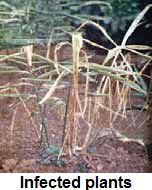 The infected plants remain yellow and stunted in growth.
The infected plants remain yellow and stunted in growth.- The yellowing start from lower leaves.
- From infection to total collapse is gradual.
- Infected plants produce shriveled tubers and brown ground tissue.
- Infected seed pieces and soil are source of primary inoculum.
- Resting spores i.e. chlamydo spores present in soil are source of secondary infection.
- High rainfall and poor drained soil favour in development of disease.
Sheath blight / leaf blight
Disease symptoms- The lesions are usually observed on the leaf sheaths although leaf blades may also be affected.
- Initially, lesions are small, ellipsoid or ovoid, and greenish-gray and usually develop near the water line in lowland fields.
- Under favorable conditions, they enlarge and may coalesce to form bigger lesions with irregular outline and grayish-white center with dark brown borders.
- The presence of several large spots on a leaf sheath usually causes the death of the whole leaf.
- Fungus survives in the soil for many years in the form of sclerotia and spreads through soil & infected rhizomes
- The pathogen prefers warm wet weather and outbreaks typically occur in the early summer months most symptoms of the pathogen do not occur until late summer.
Dry rot
Disease symptoms- Symptom includes discolouration of rhizome surface by fungal mycelia accompanied by dry rotting.
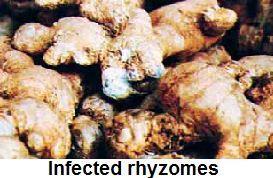 Soil and infected rhizome pieces are source of primary inoculum.
Soil and infected rhizome pieces are source of primary inoculum.- The fungus also produces resting structures (Chlamydospores) in the decomposing tissues of infected rhizomes. Therefore, tissues from infected crops remaining in the field serve as a reservoir of the fungus.
- The pathogen is known to prefer warm wet weather, coupled with high soil moisture.
IPM for Ginger
To know the IPM practices for Ginger, click here.
Source: NIPHM and Directorate of Plant Protection, Quarantine & Storage
Last Modified : 1/14/2020
© C–DAC.All content appearing on the vikaspedia portal is through collaborative effort of vikaspedia and its partners.We encourage you to use and share the content in a respectful and fair manner. Please leave all source links intact and adhere to applicable copyright and intellectual property guidelines and laws.
RELATED ITEMS
Fig Diseases
This topic covers information about Fig Diseases.
Amla Diseases
This topic covers information about Amla Diseases ...
Curryleaf Pests and Diseases
This topic provides information about Curryleaf Pe...
Ber Diseases
This topic covers information about Ber Diseases.
